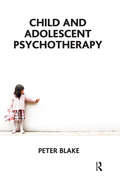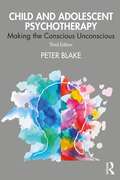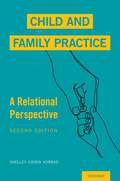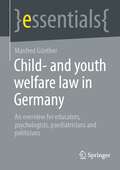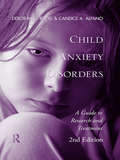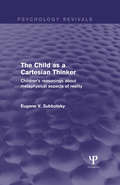- Table View
- List View
Child and Adolescent Psychology: Typical and Atypical Development
by Stephen von TetzchnerChild and Adolescent Psychology provides an accessible and thorough introduction to human development by integrating insights from typical and atypical development. This integration cements understanding since the same processes are involved. Knowledge about atypical development informs the understanding of typical development, and knowledge about typical development is a necessary basis for understanding atypical development and working with children with disorders. Based on international research, and informed by biological, social and cultural perspectives, the book provides explanations of developmental phenomena, with a focus on how children and adolescents at different age levels actually think, feel and act. Following a structure by topic, with chronological developments within each chapter, von Tetzchner presents and contrasts the major theoretical ideas in developmental psychology and discusses their implications for different aspects of development. He also integrates information about sensory, physical and cognitive disabilities and the main emotional and behavioral disorders of childhood and adolescence, and the developmental consequences of these disabilities and disorders. Child and Adolescent Psychology is accompanied by online resources for lecturers and students to enhance the book, including essay questions for each chapter, Powerpoint slides and multiple-choice questions. The book and companion website will prove invaluable to developmental psychology students.
Child and Adolescent Psychopathology: Theoretical and Clinical Implications
by Cecilia A. EssauHow do biological and environmental factors influence the development of childhood and adolescent disorders? There has been a substantial increase of interest in research into child and adolescent psychopathology. In this book, Cecilia Essau brings together contributions from the UK, the US and Canada to provide a comprehensive summary of the information available on the subject. Beginning with an introduction to general issues related to child and adolescent psychopathology, including theoretical models of normal and abnormal development, each chapter goes on to address the issues associated with specific disorders, such as: oppositional defiant disorder and conduct disorder attention-deficit/hyperactivity disorder eating disorders substance use disorders somatoform disorders. The contributors present a thorough overview of each disorder, including discussion of definition and classification, epidemiology, risk factors, comorbidity, course, outcome and prevention. Child & Adolescent Psychopathology will be welcomed by all mental health professionals seeking a reliable source of scientifically and clinically relevant information on the nature and treatment of child and adolescent disorders.
Child and Adolescent Psychopathology: Theoretical and Clinical Implications
by Cecilia A. EssauHow do biological and environmental factors influence the development of childhood and adolescent disorders? There has been a substantial increase of interest in research into child and adolescent psychopathology. In this book, Cecilia Essau brings together contributions from the UK, the US and Canada to provide a comprehensive summary of the information available on the subject. Beginning with an introduction to general issues related to child and adolescent psychopathology, including theoretical models of normal and abnormal development, each chapter goes on to address the issues associated with specific disorders, such as: oppositional defiant disorder and conduct disorder attention-deficit/hyperactivity disorder eating disorders substance use disorders somatoform disorders. The contributors present a thorough overview of each disorder, including discussion of definition and classification, epidemiology, risk factors, comorbidity, course, outcome and prevention. Child & Adolescent Psychopathology will be welcomed by all mental health professionals seeking a reliable source of scientifically and clinically relevant information on the nature and treatment of child and adolescent disorders.
Child and Adolescent Psychopathology
by Theodore P. Beauchaine Stephen P. HinshawA unique, multi-discipline, developmental approach to childhood psychopathology Child and Adolescent Psychopathology is the only comprehensive text in the field to address genetic, neurobiological, and environmental factors within a developmental context. Based on cutting-edge research and aligned with the DSM-5, this book emphasizes how, when, and why disorders emerge among young people, and the ways in which symptom profiles change at different stages of development. This new third edition has been updated to include new chapters on OCD and trauma disorders consistent with DSM-5 classification, and includes new discussion on epigenetics and the neighborhood effects on the development of delinquency. Coverage includes extensive discussion of risk factors, from disturbed attachment relations and abuse/neglect, to head injury and teratogen exposure, followed by in-depth examination of behavior disorders and psychological disorders including Autism Spectrum, Schizophrenia Spectrum, and Eating Disorders. Psychological disorders in children are increasingly being explored from a relational perspective, and continuous advances in neurobiology research are adding an additional dimension to our understanding of cause, effect, and appropriate intervention. This book provides detailed guidance toward all aspects of childhood psychopathology, with a multi-discipline approach and a unique developmental emphasis. Discover how psychopathology emerges throughout the stages of development Learn how both genetics and environmental factors influence risk and behaviors Understand the prevalence, risk factors, and progression of each disorder Gain deep insight from leading experts in neurobiology and developmental psychopathology As the field of child psychology continues to evolve, behavioral and psychological disorders move beyond a list of symptoms to encompass the 'whole child'—biology, chemistry, environment, and culture are becoming increasingly relevant in understanding and treating these disorders, and must be considered from the earliest assessment stages. Child and Adolescent Psychopathology provides comprehensive information on childhood disorders from a developmental perspective.
Child and Adolescent Psychopathology
by Theodore P. Beauchaine Stephen P. HinshawA unique, multi-discipline, developmental approach to childhood psychopathology Child and Adolescent Psychopathology is the only comprehensive text in the field to address genetic, neurobiological, and environmental factors within a developmental context. Based on cutting-edge research and aligned with the DSM-5, this book emphasizes how, when, and why disorders emerge among young people, and the ways in which symptom profiles change at different stages of development. This new third edition has been updated to include new chapters on OCD and trauma disorders consistent with DSM-5 classification, and includes new discussion on epigenetics and the neighborhood effects on the development of delinquency. Coverage includes extensive discussion of risk factors, from disturbed attachment relations and abuse/neglect, to head injury and teratogen exposure, followed by in-depth examination of behavior disorders and psychological disorders including Autism Spectrum, Schizophrenia Spectrum, and Eating Disorders. Psychological disorders in children are increasingly being explored from a relational perspective, and continuous advances in neurobiology research are adding an additional dimension to our understanding of cause, effect, and appropriate intervention. This book provides detailed guidance toward all aspects of childhood psychopathology, with a multi-discipline approach and a unique developmental emphasis. Discover how psychopathology emerges throughout the stages of development Learn how both genetics and environmental factors influence risk and behaviors Understand the prevalence, risk factors, and progression of each disorder Gain deep insight from leading experts in neurobiology and developmental psychopathology As the field of child psychology continues to evolve, behavioral and psychological disorders move beyond a list of symptoms to encompass the 'whole child'—biology, chemistry, environment, and culture are becoming increasingly relevant in understanding and treating these disorders, and must be considered from the earliest assessment stages. Child and Adolescent Psychopathology provides comprehensive information on childhood disorders from a developmental perspective.
Child and Adolescent Psychotherapy
by Peter BlakeIn this book, Peter Blake articulates his clinical practice of child and adolescent psychotherapy. A clear conceptual framework and historical context is provided for the work. The book is then structured to follow the therapeutic process, from assessment (referral and initial interview, individual assessment, developmental considerations, assessment for therapy, working with parents) to therapy (physical and mental settings, interpretation, the role and challenges of play, transference and countertransference, termination). Drawing on the Winnicottian tradition, in which fun and humour have a place in child and adolescent work, Blake demonstrates how a therapist can be playful and less directly interpretative. How psychodynamic thinking can be applied in an effective yet time-limited manner is also demonstrated. The text is enlivened by many case studies and clinical anecdotes. For therapists who are new to child and adolescent psychotherapy, and who wish to take a psychodynamic approach, the book will provide a valuable introduction.
Child and Adolescent Psychotherapy
by Peter BlakeIn this book, Peter Blake articulates his clinical practice of child and adolescent psychotherapy. A clear conceptual framework and historical context is provided for the work. The book is then structured to follow the therapeutic process, from assessment (referral and initial interview, individual assessment, developmental considerations, assessment for therapy, working with parents) to therapy (physical and mental settings, interpretation, the role and challenges of play, transference and countertransference, termination). Drawing on the Winnicottian tradition, in which fun and humour have a place in child and adolescent work, Blake demonstrates how a therapist can be playful and less directly interpretative. How psychodynamic thinking can be applied in an effective yet time-limited manner is also demonstrated. The text is enlivened by many case studies and clinical anecdotes. For therapists who are new to child and adolescent psychotherapy, and who wish to take a psychodynamic approach, the book will provide a valuable introduction.
Child and Adolescent Psychotherapy: Making the Conscious Unconscious
by Peter BlakeIn this new edition Blake gives a personal account of his professional experience of working with children and adolescents over the last 45 years. Providing a wonderful integration of the conceptual and the practical, this book clarifies complex theory while giving practical advice for clinicians through a nuts and bolts description of how to interview parents, emotionally assess a child and adolescent, set up a consulting room and conduct a therapy session. The addition of chapter summaries, questions and suggested further readings provides a valuable structure to those in child and adolescent training programmes. The author’s experience, gained from public and private work, is vividly described with the use of clinical examples to illustrate his thinking and way of working. This third edition highlights his evolution from a more traditional epistemological (knowing) approach, with its emphasis on interpretation and insight, to a more ontological (being) framework. He explores a more intuitive and unconscious way of working and argues this is more developmentally appropriate to children and adolescents. His accessible writing style transports the reader into his clinical world: a world full of fascinating stories of children talking through their play; of adolescents exploring who they are through their discussions about music, films, sport and computer games; of helping parents to understand and thoughtfully manage their child’s emotional struggles. This new edition, an amalgam of theoretical orientations (Kleinian, Bionian, Winnicottian, relational, non-linear and neurological), draws from recent developments, both in theory and technique. It will be of immense value to psychotherapists, psychoanalysts and all those involved in the treatment of children’s mental health.
Child and Adolescent Psychotherapy: Making the Conscious Unconscious
by Peter BlakeIn this new edition Blake gives a personal account of his professional experience of working with children and adolescents over the last 45 years. Providing a wonderful integration of the conceptual and the practical, this book clarifies complex theory while giving practical advice for clinicians through a nuts and bolts description of how to interview parents, emotionally assess a child and adolescent, set up a consulting room and conduct a therapy session. The addition of chapter summaries, questions and suggested further readings provides a valuable structure to those in child and adolescent training programmes. The author’s experience, gained from public and private work, is vividly described with the use of clinical examples to illustrate his thinking and way of working. This third edition highlights his evolution from a more traditional epistemological (knowing) approach, with its emphasis on interpretation and insight, to a more ontological (being) framework. He explores a more intuitive and unconscious way of working and argues this is more developmentally appropriate to children and adolescents. His accessible writing style transports the reader into his clinical world: a world full of fascinating stories of children talking through their play; of adolescents exploring who they are through their discussions about music, films, sport and computer games; of helping parents to understand and thoughtfully manage their child’s emotional struggles. This new edition, an amalgam of theoretical orientations (Kleinian, Bionian, Winnicottian, relational, non-linear and neurological), draws from recent developments, both in theory and technique. It will be of immense value to psychotherapists, psychoanalysts and all those involved in the treatment of children’s mental health.
Child and Adolescent Resilience Within Medical Contexts: Integrating Research and Practice
by Carey DeMichelis Michel FerrariThis book explores the social conditions that promote pediatric resilience. It presents resilience as a set of complex interpersonal, institutional, and political relationships that affect young patients’ ability to “do well” in the face of medical adversity. Chapters analyze the impact of chronic or disabling conditions on children’s development, while highlighting effective interventions that promote family well-being. This book integrates research from psychology, social work, medical anthropology, child life specialty, palliative care, public health, and nursing to examine a wide variety of family, cultural, and medical contexts. Practical strategies for supporting children and families are discussed, from meaningful assessment and interventions to social policy and advocacy.Featured topics include:Psychosocial factors influencing children with immune-related health conditions. Resilience and pediatric cancer survivorship within a cultural context.Promoting resilience in chronically ill children and their families during the transition to adolescence.Creating a context for resilience in medical settings. Promoting resilience through children’s health and social care policy.Child and Adolescent Resilience Within Medical Contexts is a must-have resource for researchers, clinicians and other professionals, as well as graduate students in child and school psychology, child and adolescent psychiatry, social work, pediatrics, medical anthropology, nursing, educational psychology and policy.
Child and Adult Development: A Psychoanalytic Introduction for Clinicians (Critical Issues in Psychiatry)
by Calvin A. ColarussoDevelopmental theory is the essence of any psychodynamic psychother apy, and certainly of psychoanalysis. It is through an understanding of progressive life events, and the way these events relate to associated biological and social events, that we come to understand both psycho pathology and psychological strengths. For a long time we have needed a clinically oriented book that surveys normal development in both childhood and adulthood. This book should be particularly helpful to all mental health professionals whose daily work requires a constant awareness and appraisal of devel opmental issues. Dr. Colarusso has integrated and summarized a tremen dous amount of theoretical, empirical, and clinical material in a format that makes it come alive through clinical examples. This book should be of great interest to all students of human behav ior as well as to seasoned clinicians. SHERWYN M. WOODS, M. D. , PH. D. vii Preface Each year as I gave a lecture series on child and adult development to the adult and child psychiatric residents at the University of California at San Diego, someone inevitably would ask, "Is there a book that I could understand that has all of this information in it?" I would reply that I did not know of any single source, but I could refer the person to many articles and books on development.
Child and Family Advocacy: Bridging the Gaps Between Research, Practice, and Policy (Issues in Clinical Child Psychology)
by Anne McDonald CulpCurrent statistics on child abuse, neglect, poverty, and hunger shock the conscience—doubly so as societal structures set up to assist families are failing them. More than ever, the responsibility of the helping professions extends from aiding individuals and families to securing social justice for the larger community.With this duty in clear sight, the contributors to Child and Family Advocacy assert that advocacy is neither a dying art nor a lost cause but a vital platform for improving children's lives beyond the scope of clinical practice. This uniquely practical reference builds an ethical foundation that defines advocacy as a professional competency and identifies skills that clinicians and researchers can use in advocating at the local, state and federal levels. Models of the advocacy process coupled with first-person narratives demonstrate how professionals across disciplines can lobby for change.Among the topics discussed: Promoting children's mental health: collaboration and public understanding.Health reform as a bridge to health equity.Preventing child maltreatment: early intervention and public educationChanging juvenile justice practice and policy.A multi-level framework for local policy development and implementation.When evidence and values collide: preventing sexually transmitted infections.Lessons from the legislative history of federal special education law. Child and Family Advocacy is an essential resource for researchers, professionals and graduate students in clinical child and school psychology, family studies, public health, developmental psychology, social work and social policy.
Child and Family Assessment: Clinical Guidelines for Practitioners
by Ian WilkinsonChild and Family Assessment is based on Ian Wilkinson's extensive experience of working with troubled children and families over the last twenty years. This completely revised and updated edition of Family Assessment (Gardner Press, 1993) combines a clear summary of current knowledge with practical, detailed and adaptable procedures for practitioner use. Part one reviews the literature on child and family assessment; part two discusses the practical issues involved and provides detailed guidelines for practitioners; a final part examines the relationship between clinical practice, assessment and science with respect to children and families. Written from an eclectic point of view in a clear and precise style, using common sense terms, this book will be an essential guide for all those in the helping professions, including therapists, psychologists, doctors, nurses, social workers and lawyers.
Child and Family Assessment: Clinical Guidelines for Practitioners
by Ian WilkinsonChild and Family Assessment is based on Ian Wilkinson's extensive experience of working with troubled children and families over the last twenty years. This completely revised and updated edition of Family Assessment (Gardner Press, 1993) combines a clear summary of current knowledge with practical, detailed and adaptable procedures for practitioner use. Part one reviews the literature on child and family assessment; part two discusses the practical issues involved and provides detailed guidelines for practitioners; a final part examines the relationship between clinical practice, assessment and science with respect to children and families. Written from an eclectic point of view in a clear and precise style, using common sense terms, this book will be an essential guide for all those in the helping professions, including therapists, psychologists, doctors, nurses, social workers and lawyers.
Child and Family Practice: A Relational Perspective
by Shelley Cohen KonradChild and Family Practice: A Relational Perspective, Second Edition presents important guidelines and principles for working with children, their families, and their service-providing organizations. It is grounded in the traditional social work theories of relationship with emphasis on three core concepts: relational connection, evidence-guided knowledge, and reflexivity. With this text students can connect theory to evidence-based practice and use realistic case studies for classroom role-play and engaging discussion. Cohen Konrad's goal is to help students connect science, theory, and the human qualities necessary to effect positive change and inspire hope in the lives of children and families.
Child and Family Practice: A Relational Perspective
by Shelley Cohen KonradChild and Family Practice: A Relational Perspective, Second Edition presents important guidelines and principles for working with children, their families, and their service-providing organizations. It is grounded in the traditional social work theories of relationship with emphasis on three core concepts: relational connection, evidence-guided knowledge, and reflexivity. With this text students can connect theory to evidence-based practice and use realistic case studies for classroom role-play and engaging discussion. Cohen Konrad's goal is to help students connect science, theory, and the human qualities necessary to effect positive change and inspire hope in the lives of children and families.
Child and Family Well-Being and Homelessness: Integrating Research into Practice and Policy (SpringerBriefs in Psychology)
by Mary E. HaskettThis brief highlights several of the most pressing challenges in addressing the needs of families who are experiencing homelessness and presents a set of strong policy recommendations for assessment, intervention, research, and service delivery related to homeless children and their parents. Chapters increase awareness of the mental health, educational, and developmental challenges faced by these children and their parents. In addition, chapters provide practice implications of current research with a focus on the importance of careful assessment of service and housing needs; individual differences in strengths and adjustment of parents and children experiencing homelessness; and innovative treatment and service delivery approaches to address the unique needs of this population. Featured topics include: Promoting positive parenting among homeless families.Innovative intervention, assessment, and service delivery models.Homeless children and early childhood care and education systems. Early Risers intervention & Community Action Targeting Children who are Homeless Project (Project CATCH).Child and Family Well-Being and Homelessness is an essential resource for policy makers and related professionals and for graduate students and researchers in developmental, clinical, and school psychology; child, youth and family policy; public health; and social work.
The Child and Its Family (Genesis of Behavior #2)
by Michael Lewis and Leonard A. RosenblumHow are we to understand the complex forces that shape human behavior? A variety of diverse perspectives, drawing upon studies of human behavioral ontogeny, as well as humanity's evolutionary heri tage, seem to provide the best likelihood of success. It is in the attempt to synthesize such potentially disparate approaches to human develop ment into an integrated whole that we undertake this series on the Genesis of Behavior. In many respects, the incredible burgeoning of research in child development over the last decade or two seems like a thousand lines of inquiry spreading outward in an incoherent starburst of effort. The need exists to provide, on an ongoing basis, an arena of discourse within which the threads of continuity between those diverse lines of research on human development can be woven into a fabric of meaning and understanding. Scientists, scholars, and those who attempt to translate their efforts into the practical realities of the care and guidance of infants and children are the audience that we seek to reach. Each requires the opportunity to see-to the degree that our knowledge in given areas permits-various aspects of development in a coherent, integrated fashion. It is hoped that this series, which will bring together research on infant biology, developing infant capacities, animal models, the impact of social, cultural, and familial forces on development, and the distorted products of such forces under certain circumstances, will serve these important social and scientific needs.
Child- and youth welfare law in Germany: An overview for educators, psychologists, paediatricians and politicians (essentials)
by Manfred GüntherTaking into account the KJSG of June 2021, the author presents child and youth law with SGB VIII at its centre in a clear and compact manner. Analyses and commentary appear consistently up-to-date and comprehensible, as he largely dispenses with legalese. Readers - custodial parents, other guardians, young people concerned, social educators in institutions, students - and last but not least the committed "lobbyists" in the youth welfare committees - are thus provided with a quick, profound overview of the essential policy and practice-relevant positions; the focus is on legal entitlements: offers, services as well as important and useful general regulations of the German Social Code for Child and Youth Welfare.
Child Anxiety Disorders: A Guide to Research and Treatment, 2nd Edition
by Deborah C. Beidel Candice A. AlfanoChildhood anxiety disorders represent one of the most common psychological disorders found among the general population. They can be serious, distressful, and functionally impairing, so much so that there has been an explosion of interest in their treatment, primarily from pharmacological and cognitive-behavioral perspectives.Addressing these perspectives is the Second Edition of Child Anxiety Disorders. Beidel and Alfano pay close attention to new pharmacological and psychological interventions as well as multi-center trials that compare single and combined treatment modalities. Additionally, they include new case studies, sections on stability of childhood fears and the longitudinal course of anxiety disorders, and a new chapter on sleep and anxiety disorders. Written on the cusp of newly published information and studies, Child Anxiety Disorders is relevant, informative, and indispensible.
Child Anxiety Disorders: A Guide to Research and Treatment, 2nd Edition
by Deborah C. Beidel Candice A. AlfanoChildhood anxiety disorders represent one of the most common psychological disorders found among the general population. They can be serious, distressful, and functionally impairing, so much so that there has been an explosion of interest in their treatment, primarily from pharmacological and cognitive-behavioral perspectives.Addressing these perspectives is the Second Edition of Child Anxiety Disorders. Beidel and Alfano pay close attention to new pharmacological and psychological interventions as well as multi-center trials that compare single and combined treatment modalities. Additionally, they include new case studies, sections on stability of childhood fears and the longitudinal course of anxiety disorders, and a new chapter on sleep and anxiety disorders. Written on the cusp of newly published information and studies, Child Anxiety Disorders is relevant, informative, and indispensible.
Child Art Therapy: Understanding And Helping Children Grow Through Art
by Judith Aron RubinAn innovative guide to the practice of art therapy Since 1978, Judith Aron Rubin's Child Art Therapy has become the classic text for conducting art therapy with children. Twenty-five years later, the book still stands as the reference for mental health professionals who incorporate art into their practice. Now, with the publication of this fully updated and revised Twenty-Fifth Anniversary Edition, which includes a DVD that illustrates art therapy techniques in actual therapy settings, this pioneering guide is available to train, inform, and inspire a new generation of art therapists and those seeking to introduce art therapy into their clinical practice. The text illustrates how to: Set the conditions for creative growth, assess progress, and set goals for therapy Use art in individual, group, and family situations, including parent-child pairings, mothers' groups, and adolescent groups Work with healthy children and those with disabilities Guide parents through art and play Talk about art work and encourage art production Decode nonverbal messages contained in art and the art-making process Use scribbles, drawings, stories, poems, masks, and other methods to facilitate expression Understand why and how art therapy works Along with the useful techniques and activities described, numerous case studies taken from Rubin's years of practice add a vital dimension to the text, exploring how art therapy works in the real world of children's experience. Original artwork from clients and the author illuminate the material throughout. Written by an internationally recognized art therapist, Child Art Therapy, Twenty-Fifth Anniversary Edition is a comprehensive guide for learning about, practicing, and refining child art therapy.
Child Art Therapy
by Judith Aron RubinAn innovative guide to the practice of art therapy Since 1978, Judith Aron Rubin's Child Art Therapy has become the classic text for conducting art therapy with children. Twenty-five years later, the book still stands as the reference for mental health professionals who incorporate art into their practice. Now, with the publication of this fully updated and revised Twenty-Fifth Anniversary Edition, which includes a DVD that illustrates art therapy techniques in actual therapy settings, this pioneering guide is available to train, inform, and inspire a new generation of art therapists and those seeking to introduce art therapy into their clinical practice. The text illustrates how to: Set the conditions for creative growth, assess progress, and set goals for therapy Use art in individual, group, and family situations, including parent-child pairings, mothers' groups, and adolescent groups Work with healthy children and those with disabilities Guide parents through art and play Talk about art work and encourage art production Decode nonverbal messages contained in art and the art-making process Use scribbles, drawings, stories, poems, masks, and other methods to facilitate expression Understand why and how art therapy works Along with the useful techniques and activities described, numerous case studies taken from Rubin's years of practice add a vital dimension to the text, exploring how art therapy works in the real world of children's experience. Original artwork from clients and the author illuminate the material throughout. Written by an internationally recognized art therapist, Child Art Therapy, Twenty-Fifth Anniversary Edition is a comprehensive guide for learning about, practicing, and refining child art therapy.
The Child as a Cartesian Thinker: Children's Reasonings about Metaphysical Aspects of Reality (Psychology Revivals)
by Eugene V. SubbotskyOriginally published in 1996, this book presents and analyses children’s reasonings about fundamental metaphysical problems. The first part describes dialogues with children that were constructed on the basis of Descartes’ Mediations on First Philosophy and which look at children’s ideas about the relationships between true and false knowledge, mental images and physical objects, mind and body, personal existence and the external world, dreams and reality, and the existence of the Supreme Being, among others. The second part of the book draws on concepts that children of various ages have about psychological and metapsychological aspects of human reality such as: cognitive and moral development; personal freedom and responsibility; the relationships between conscious and unconscious; living and non-living; and about the fundamental drives of an individual for development and expansion of his or her needs and passions, for eternal life, and for the dreamlike world of fulfilled wishes. The book presents a systematic empirical and theoretical study of the problems, some of which were touched on in Piaget’s early writing but which he later abandoned and which were only sporadically illuminated by other authors, whereas others were completely new to research in developmental psychology at the time. It will still be a helpful guide for developmental psychologists, teachers, educationalists, social workers, lawyers, and other professionals interested in the knowledge that 4- to 14-year-old children have about the most fundamental aspects of reality and human beings.
The Child as a Cartesian Thinker: Children's Reasonings about Metaphysical Aspects of Reality (Psychology Revivals)
by Eugene V. SubbotskyOriginally published in 1996, this book presents and analyses children’s reasonings about fundamental metaphysical problems. The first part describes dialogues with children that were constructed on the basis of Descartes’ Mediations on First Philosophy and which look at children’s ideas about the relationships between true and false knowledge, mental images and physical objects, mind and body, personal existence and the external world, dreams and reality, and the existence of the Supreme Being, among others. The second part of the book draws on concepts that children of various ages have about psychological and metapsychological aspects of human reality such as: cognitive and moral development; personal freedom and responsibility; the relationships between conscious and unconscious; living and non-living; and about the fundamental drives of an individual for development and expansion of his or her needs and passions, for eternal life, and for the dreamlike world of fulfilled wishes. The book presents a systematic empirical and theoretical study of the problems, some of which were touched on in Piaget’s early writing but which he later abandoned and which were only sporadically illuminated by other authors, whereas others were completely new to research in developmental psychology at the time. It will still be a helpful guide for developmental psychologists, teachers, educationalists, social workers, lawyers, and other professionals interested in the knowledge that 4- to 14-year-old children have about the most fundamental aspects of reality and human beings.



